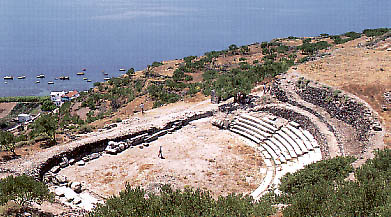
|
|
---------VG TRAVEL CLUB PRESENTS YOU VACATION-GREECE.COM--------- |
|||||
|
||||||
|
---------YOUR TRAVEL GUIDE IN GREECE AND THE GREEK ISLANDS--------- |
|
|
HISTORICAL ELEMENTS OF MILOS
In ancient times, Milos prospered because of its great mineral wealth. It has been inhabited since the Neolithic age (7000 B.C.) and developed more rapidly than the neighbouring islands because of a black glass-like volcanic rock called obsidian which was used by the "Milians" to make tools and weapons. Since obsidian from Milos has also been located in the Peloponnese, Crete, Cyprus and even in Egypt, it is believed that there was a flourishing export trade too.
Roman Theatre
From the beginning of the bronze age, (2800 - 1100 B.C.), the island played an extremely important part in the Cycladic world, centered at the ancient city of Philakopi, which in fact gave its name to an entire archaeological period.
|
With the arrival of the Hellenic People, The Dorians settled in Milos around 1000 B.C. During the same period, a new settlement was being built in the area of modern Klima. This new town developed rapidly particularly in the field of art and craft. The so called "Melian Vases" of that period are still admired by the experts and people as well. Very little is known from ancient sources about Milos before the 5th century B.C. It is known however, that the Milians refused to surrender to the Persians and fought alongside with the rest of the Greeks at the battles of Salamina and Plataea. In their attempt to remain neutral during the Peloponnesian War, they were punished by the Athenians who, in 415 B.C. put all the old people to death and sold the young men, women and children into slavery. The history of the island, throughout the following centuries, was similar to that of the rest of the Cycladic Islands. Until 311 B.C., Milos was ruled by Macedonia and then by Egypt. The powerful fleet of the Ptolemaids ensured the freedom and safety of the seas. As a result, the island of Milos saw a phase of renewed economic growth which was reflected culturally too. Examples of this creative era are the famous statue of Aphrodite (Venus of Milos), which is nowdays found in the Louvre Museum in Paris), and the imposing 2,5 meter tall statue of Poseidon (Neptune), displayed in the National Museum in Athens. The most important event in the Byzantine era was the destruction of the Ancient City at Klima (5th - 6th century) possibly as a result of an earthquake. Finally, during the Venetian and Turkish rule, the inhabitants fought relentlessly for their freedom. |
Catacombs
|
|
|
|
|
BACK TO CYCLADES / MILOS ISLAND HOTELS
|
VG - Travel Club - Agiou Tryfona 15, 152 36, Palaia Penteli, Athens, GREECE |
|
|
|
Tel: +30210-8047244, +30210-8104389, Fax: +30210-6131148, e-mail: greece@vacation-greece.com |